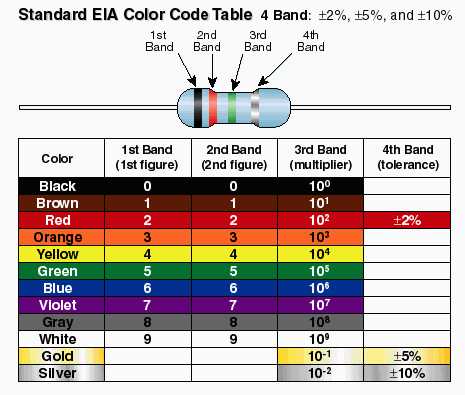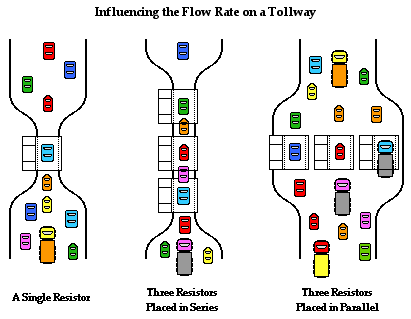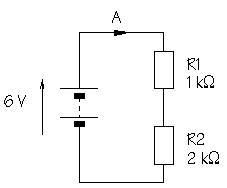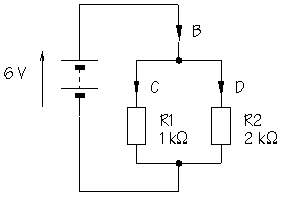Resistance: Ohm´s Law
What is Electrical Resistance?
When electrons flow through a bulb or another conductor, the conductor does offers some obstruction to the current. This obstruction is called electrical resistance.
- The longer the conductor higher the resistance.
- The smaller its area the higher its resistance
Every material has an electrical resistance and it is the reason that the conductor give out heat when the current passes through it.
Resistance is a measure of how much an object opposes the passage of electrons. The unit of electrical resistance is the ohm and it is represented by Ω
Every material has Resistance. Copper has a low resistance and wood has a high resistance. For example, a metre of copper has a resistance of only 1 Ohm but a metre of wood has a resistance of 10000000 ohm
copper has a resistance of only 1 Ohm but a metre of wood has a resistance of 10000000 ohm
We need resistance to reduce the flow of electrons through a circuit, so we can build resistors to behave as Electrical resistance. On the right, a resistor used in the electronic industry.
Reading Resistor Values
The resistance of resistors is indicated using colour-coded bands on the body of the resistor. The first three colour bands indicate the value of the resistor in Ohms. The first band tells us the first digit, the second band tell us the second digit and the third band tell us the number of zeros

Examples:
A) If the first band is green (5) the second digit is blue (6) and the third band is orange (3), the value of the resistor is 56000 ohm. Because 1000 Ohm = 1 K, we have 56k
B) red, red, yellow. So we have 2, 2, 0000 or 220.000 Ohm
Exercices
1. What resistor values are indicated by the following colour bands? (A) red, black, red (B) grey, red, orange (C) orange, white, blue (D) green, white, black 2. What are the colour codes for the following resistance values? (A) 2.2k (B) 270 (C) 56 k 3. What are the maximum and minimum values of a resistor with the following colours: Red, orange, brown with a gold tolerance band
Designing a resistor network. Resistors in series.
 Sometimes you need a particular kind of resistor, but you don’t have it on hand or it doesn’t exist. Fortunately, it’s possible to use several different resistors in combination to get virtually any level of resistance, for example, if you have 2 resistors of 20 Ohm and you need a resistor of 40 Ohm, just add them both together in series, so Rt = R1 + R2 + ……… ( Serial ).
Sometimes you need a particular kind of resistor, but you don’t have it on hand or it doesn’t exist. Fortunately, it’s possible to use several different resistors in combination to get virtually any level of resistance, for example, if you have 2 resistors of 20 Ohm and you need a resistor of 40 Ohm, just add them both together in series, so Rt = R1 + R2 + ……… ( Serial ).
In the Figure you can see three resistors, but this time they’re connected in parallel. Each electron will flow through one of the three resistors. These three resistors have a equivalent resistor of:
1/Rt = 1/R1 + 1/R2 + 1/R3
Ok, but why ?
Let’s make a traffic analogy and talk of electrons as cars. This is a picture of three possible toll booth situations on a motorway.
1º In the first case, we have a one-way path. First, the conductor, low resistance and fluid traffic. Later, a resistor in series with the wire, so a bottleneck area through which it is somewhat difficult for the electrons to move. Later, the conductor again with the electrons moving better.
2º In the second case, we add two resistors in series, so the total resistance will be increased, consequently less electrons will flow in the conductor
3º Quite obviously, adding resistors in parallel would have the overall affect of ” building a three-lane motorway”, decreasing the total resistance and increasing the overall car flow rate (electron flow) along the wire. In the case of adding more resistors in parallel, less overall resistance is created.

In a battery, chemical energy is converted into electrical energy. The electrical charges get electric potential and kinetic energy as they pass through the battery.
The average kinetic energy of the moving charges remains the same. The lost potential energy is converted into heat as the charges move around the circuit.
Remember some important concepts
1ºElectricity is the movement of electrons through a material. Electron flows along like a water current in a stream, so we call it Electric current. Current ( I) is the number of electrons which flow through a wire per second. Current is measured in Amp
You need something to give energy to electrons. You need a battery and the power of it is called voltage. The higher the voltage, the more power there is to drive the electrons thought the circuit. Voltage (V): The “pressure or Energy” forcing the electrons flow around the circuits. The battery supplies the “pressure.” Resistence (R) is the amount of force opposing the current, for example, from a bulb. Resistence is measured in Ohms (Ω)
Ohm´s Law
There is a relationship between Voltage, Current and Resistance. The current in a circuit ( amp) is directly proportional to the applied potential difference (volts) and inversely proportional to the resistance of the circuit ( resistance). I = v/r
Example:
I = v/r A nine volt battery supplies power to a bulb with a resistance of 18 ohms. How much current is flowing through the bulb? Solution: Substitute in the values for V(Voltage) and R(Resistance).
Exercises:
1º A 110 volt wall outlet supplies power to a TV set with a resistance of 2200 ohms. How much current is flowing through the TV? 2º A CD player with a resistance of 40 ohms has a current of 0.1 amps flowing through it. Calculate how many volts supply the CD player.
2º A CD player with a resistance of 40 ohms has a current of 0.1 amps flowing through it. Calculate how many volts supply the CD player.
Choose your answer: a) 10.0 volts b) 0.0025 volts c) 400.0 volts and d) 4.0 volts
 3º In this circuit, calculate:
3º In this circuit, calculate:
a) the total resistance in the circuit
b) the total current flowing at point A
c) The current in R1 and R2
d) The voltage in R1 and R2
 4º In this circuit the resistors are in parallel:
4º In this circuit the resistors are in parallel:
Calculate:
A) the total resistance in the circuit
B) the total current flowing at point B and the current at C and D
C) tension on R1 and R2
bottleneck: 1. A narrow or obstructed section, like on a highway or in a pipeline. 2. A point or an area of traffic congestion. 3. The narrow part of a bottle near the top.
